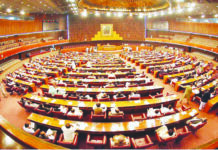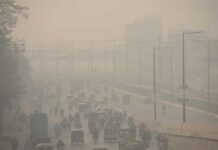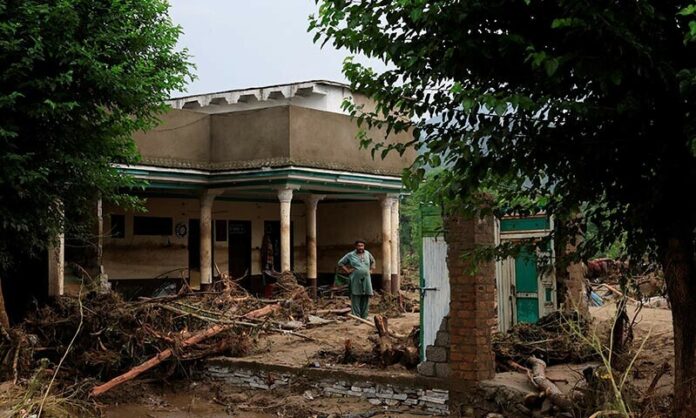— PM pledges full support for KP flood victims, announces cabinet’s one-month salary
— NDMA warns of two more monsoon spells, cloudbursts poses risk to GB, AJK
— Army engineers, relief trucks dispatched to Buner and other affected areas
— 171 children, 94 women, and 392 men died due to heavy rains across country
ISLAMABAD: The National Disaster Management Authority (NDMA) Monday against more rains and cloudburst incidents in northern parts of Pakistan as death toll during the current monsoon season reached 657 while 929 injured in various incidents across country.
Prime Minister Shehbaz Sharif pledged the federal government’s complete support for flood-hit communities in Khyber Pakhtunkhwa, announcing the donation of one month’s salary from the federal cabinet to aid relief efforts.
Chairing a meeting to review ongoing relief efforts by federal government in flood affected areas of Khyber Pakhtunkhwa, Gilgit Baltistan and Azad Jammu and Kashmir, the prime minister directed the federal institutions to intensify efforts to assist rain and flood-affected people in various districts of KP.
“In this hour of calamity, there is no federal or provincial government; we must ensure the assistance and rehabilitation of affected people,” the prime minister said adding, “Helping our distressed Pakistani brothers and sisters is our national responsibility”.
He said this was not a time for politics but for service and healing the wounds of the people. The prime minister stressed that the federal government will also provide financial assistance to the families of the deceased and affected individuals under the Prime Minister’s relief package.
Minister for Kashmir Affairs and Gilgit-Baltistan will oversee relief and rehabilitation operations in affected areas while the relevant federal ministers will personally monitor the restoration of electricity, water, roads, and other facilities in affected areas, the prime minister added.
Furthermore, he also instructed all relevant federal ministers to visit Khyber Pakhtunkhwa, Azad Kashmir, and Gilgit-Baltistan in person. The prime minister directed the National Highway Authority (NHA) not to differentiate between provincial or national highways; and opening routes for relief must be the top priority.
He also ordered Ministry of Communications, NHA, and FWO to ensure repair of highways and bridges in affected areas. Minister for Communications should personally oversee rehabilitation operations.
According to the preliminary estimates, damages to public and private property exceeded around Rs 126 million. NDMA presented a report on the provision of rations, tents, medicines, medical teams, and other essentials, with the prime minister directing an increase in the quantity of relief items.
The meeting was informed that the monsoon season will continue until the second week of September, with six major spells already passed and two more expected, with effects lasting until the last week of September.
As per official statistics released on Monday, since June 26, at least 657 people have died in rain-related incidents across Pakistan – 171 children, 94 women, and 392 men. The highest number of casualties has been reported from Khyber Pakhtunkhwa where 390 people have died so far, with hundreds injured or missing.
In Punjab, 164 people have died in rain-related incidents, with children making up the largest proportion 70. In Sindh, 28 deaths have been recorded, while Balochistan has reported 20 deaths. Thirty-two people have died in Gilgit-Baltistan, and 15 in Azad Jammu and Kashmir, including five children and as many women.
The NDMA has issued an emergency alert for various districts in Khyber Pakhtunkhwa, Punjab and Balochistan after the Pakistan Meteorological Department forecast further rainfall.
According to the alert, an active weather system is currently present over Pakistan, which could lead to more heavy rains starting today (Monday). In Islamabad, intermittent thunderstorms and heavy rainfall are expected.
In Punjab, especially the Pothohar region and northeastern districts — including Rawalpindi, Attock, Jhelum, Chakwal, Lahore, Gujranwala, Sialkot, Gujrat, Narowal, Hafizabad, and Mandi Bahauddin — heavy rainfall is expected which could cause urban flooding.
In Khyber Pakhtunkhwa province, thunderstorms and heavy rains are forecast in Peshawar, Charsadda, Nowshera, Mardan, and Swabi, while southern districts — including D.I. Khan, Tank, Bannu, Lakki Marwat, Karak, and Kohat — may also receive heavy showers.
Muzaffarabad, Rawalakot, Bagh, Haveli, Kotli, Mirpur, and Bhimber areas of Azad Kashmir are likely to experience strong winds and thunderstorms, increasing the risk of landslides and flooding in mountainous regions.
In Gilgit, Skardu, Hunza, Ghizer, Diamer, Astore, Ghanche, and Shigar, rains are expected, potentially triggering floods and landslides in various parts of the valley.
Separately, the NDMA Chairman Lieutenant General Inam Haider stated on Monday that the country is currently experiencing the seventh spell of the monsoon season, with two more spells expected to follow.
He warned that the melting of glaciers poses a threat to Gilgit-Baltistan and Kashmir, and that Islamabad and Rawalpindi could also be affected.
During a media briefing alongside Federal Minister for Climate Change Musadik Malik and Minister for Information Attaullah Tarar, the NDMA chairman said that Pakistan is passing through its seventh monsoon spell and that climate change is accelerating the melting of glaciers. He added that this trend could intensify in the coming years.
According to him, glacier melt is increasing the risk for areas like Gilgit-Baltistan and Kashmir, while cloudbursts in Khyber Pakhtunkhwa have made the monsoon situation more serious. He recalled that Pakistan had also faced severe flooding in 2022.
He revealed that so far, around 670 lives have been lost, and unfortunately, 80 to 90 people are still missing. With two more monsoon spells expected, the final one will likely pass by September 10. Complete data on the damages will be available after that date.
Lieutenant General Inam Haider said the government, with the help of the Pakistan Army and other institutions, is collecting data, and the top priority is rescuing people and relocating them to relief camps. As per the prime minister’s directives, more than 400 relief camps have been established.
Army engineers are also providing all possible support to assist those affected. Relief trucks are being dispatched in convoys to Buner and other affected areas, and every effort is being made to deliver food supplies to the victims.
The NDMA chairman added that reserve systems are in place at army aviation bases, and severely injured individuals are being taken to major hospitals. Large CMH hospitals have also been put on alert, and the Prime Minister will soon approve a national relief package to address the damages.
Federal Minister for Climate Change Musadik Malik stated that due to climate change, cloudburst conditions have emerged. He stressed that Pakistan contributes less than 1% to global carbon emissions, yet glaciers are melting due to the carbon output of major polluting nations—about 7 to 8 countries that are damaging the environment.
He said efforts are underway, in collaboration with provincial governments, to restore infrastructure and to confront this natural disaster collectively. The federal government is committed to compensating flood victims and taking meaningful steps for their rehabilitation.
Musadik Malik expressed heartfelt sympathy for the victims and emphasized that Pakistan, despite contributing little to global emissions, is bearing the brunt of the climate crisis. He assured that comprehensive efforts are being made to address the damage.
Information Minister Attaullah Tarar also addressed the media, noting that a high-level meeting chaired by the Prime Minister had taken place to review the recent flood situation caused by monsoon rains. The meeting assessed the current status in Khyber Pakhtunkhwa and Gilgit-Baltistan, as well as the ongoing relief and rescue operations.
He added that coordination with provincial governments has been effective, and several pre-monsoon planning meetings were held at the National Command and Control Centre with participation from all provincial representatives. According to him, NDMA has been consistently providing data to the relevant authorities through its early warning system, and strong national-level efforts are ongoing to manage the situation.
He concluded by saying that relief supplies and aid operations are in progress, and that the Pakistan Army and all welfare organizations are actively assisting those affected.
























To avoid death by floods storms heatwave wildfires the strong earthquakes more mag 7 earthquake non-Muslims to convert to islam and Muslims to apply the Quran 100% in Pakistan August 19,2025.